Was the Creuse the True Cradle of Impressionism?
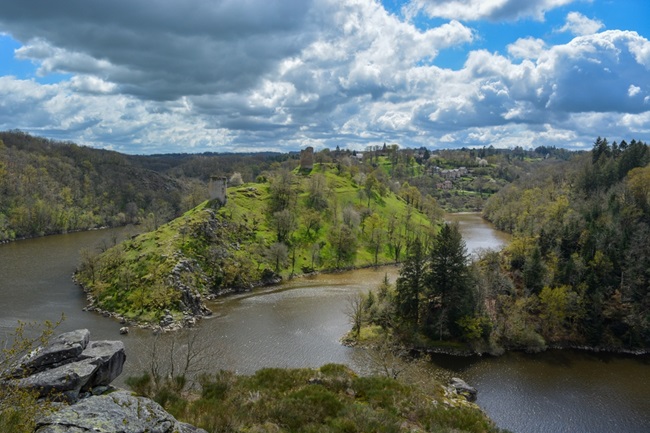
Impressionism is celebrating a milestone anniversary – 150 years since the first exhibition that marked the birth of the movement. In the tranquil Creuse, artists flocked to enjoy the light and pastoral landscapes including Claude Monet. But who are the lesser-known artists who also made the Impressionist movement?
In 1999, I fell in love with the perfect house in the small Creuse village of Fresselines. Its address, Rue Claude Monet, and the fact that I could walk straight out of the front door to the confluence of the Creuse and the Petite Creuse, painted so many times by Monet, blinded me to its faults. On the corner of the road, was the cottage in which the artist had stayed for three months in the summer of 1889. I stood staring at it, trying to imagine the great man at work.
Rumour has it, that he spent March to May of that year in a perpetual bad mood because the weather was so foul and he did nothing but complain about the changing light. He probably would not have been very happy with me casting more shadows over his work, as I unknowingly brushed past the silhouettes of numerous other artists looking over his shoulder, who had either preceded him or followed in his footsteps.
Known as the Father of Impressionism, Monet was often criticized by other Impressionists for catering to the commercial market. My curiosity about his fascination with the Creuse valley, became the key to unlocking from the black hole of my ignorance, the long-forgotten story of other artists like Léon Detroy, Eugène Alluaud, and Armand Guillaumin, lingering in the shadows of history.
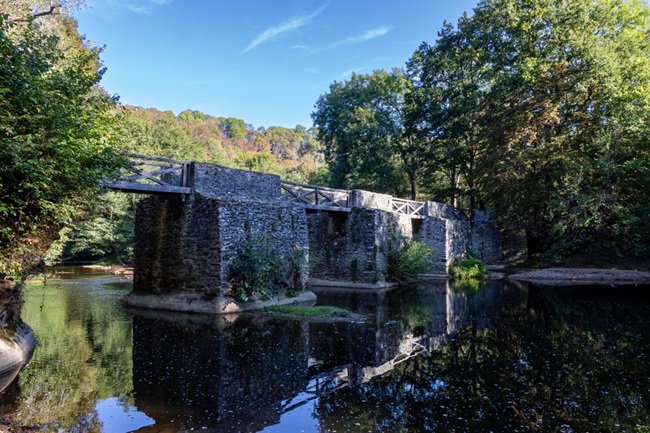
The footbridge at Fresselines © Shutterstock
At times mystical, drenched with rainbow prisms of light, other times dark, brooding and violent, the dazzling allure of the Creuse would become captured in the works of many 19th century Impressionists and Post-Impressionists. George Sand, whose home, Nohant, is a stone’s throw from the Creuse valley, says in her novel Laura, a journey into the Crystal that the artist was “born to be a traveller; everything is a journey for his spirit”. These young artists journeying to this very heart of France, could be forgiven for thinking they were in the kaleidoscopic setting of her novel, as around every river-bend and over every hill, a land of dazzling wild escarpments, striped in purple, emerald and carmine red was revealed to them.
A close friend and a regular visitor to Sand’s home, Nohant, was the French Romantic painter, Eugène Delacroix. Whilst staying at Nohant, he became familiar with the Creuse valley at Crozant. His atmospheric paintings, showing a constantly changing world, one of fantastic, savage, understated colours, made him a natural forefather of the Impressionists. He remained a prominent source of inspiration for them, prompting Cézanne to declare: “We all paint in Delacroix’s language.” With Delacroix, an icon of the Romantic movement as their source of inspiration, the First Impressionist Exhibition was held 150 years ago in April 1894 ; it should have been a success. Instead, the critics were appalled by the use of colour which relied on ‘new’ theories of light. The scenes of daily life, still-life and landscapes which they considered ‘vulgar and commonplace’ horrified them and they complained about the ‘sketchy, incomplete style of painting.’
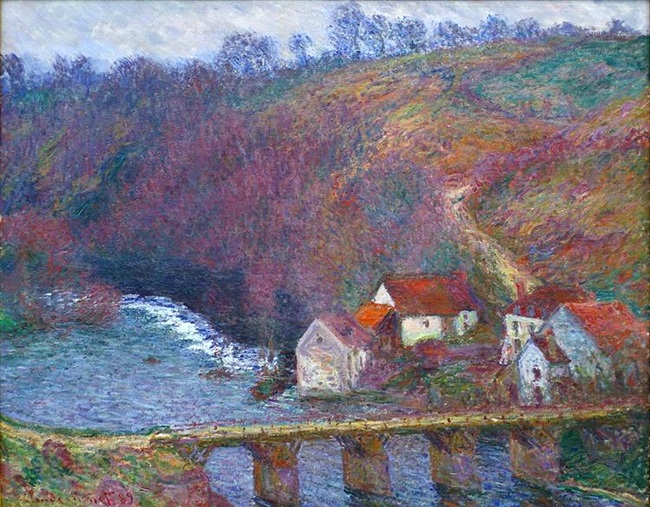
Claude Monet, The Grande Creuse by the Bridge at Vervy
Armand Guillaumin, the Fauve Impressionist
One of the founding artists of the exhibition, was Armand Guillaumin. Disillusioned after trying unsuccessfully to exhibit in the Salon of French Artists, he was encouraged by his two close friends Cézanne and Pissarro, who shared his vision of art, to join a young group of independent artists whom they supported. Although Guillaumin never achieved the same recognition as his contemporaries, he is recognized as one of the few artists who epitomise Impressionism and participated in six of the eight Impressionist exhibitions. He was already tired of Paris life when a lucky lottery win in 1891 allowed him to concentrate fully on painting and in 1892, he was persuaded by his friend Léon Detroy to move to the Fresselines area. The magical qualities of the Creuse landscape mesmerized him and he was immediately captivated by Crozant too, with its medieval castle ruins, the confluence of the rivers and its mills.
In the constantly changing light of the Creuse landscape which Monet had found distressing, Guillaumin’s use of colour came into its own. Day after day, he painted the same few favourite topics, like the Brigand Mill overlooking the ruins of the feudal castle. Fascinated by the play of light on water and the plant cover with its variation of colour, he returned tirelessly to paint the locations at different times of year. He remained faithful to Crozant to the end of his life, eating at the Auberge Lepinart and renting a house at the entrance to the village where his family joined him during the holidays. Armand Guillaumin, recognised as the leader of the Crozant School of Painters became known as the Fauve Impressionist. A bust of him stands in the square near the village church.
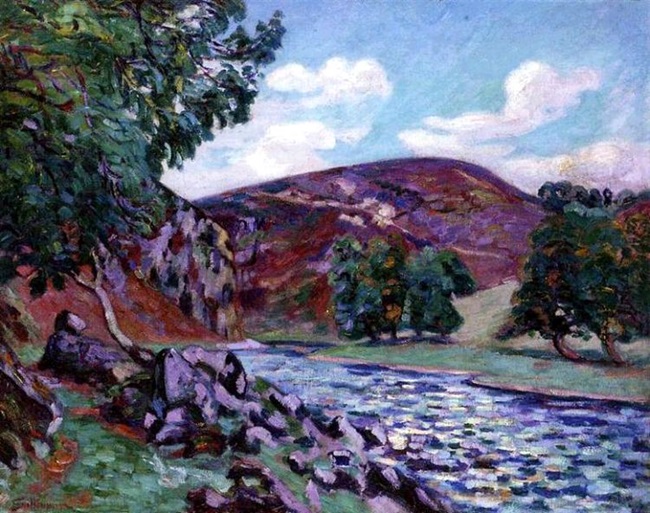
A. Guillaumin, Crozant Landscape
The Hermit Léon Detroy
His friend, Léon Detroy, known as the ‘Hermit of Gargilesse’, first discovered the Creuse valley in 1885. Two years later, he returned and stayed for 60 years, dividing his time between Fresselines, Crozant and Gargilesse, often visited by his artist friends Henri Charrier and Ernest Victor Hareux. A sensitive, perceptive man, he was always attracted by landscapes and after reading George Sand’s novels, he decided to focus his painting on her descriptions of the magical settings of her stories. A little younger than the great Impressionists, Detroy developed his own technique, using an explosive mix, of purples and violets and washing his landscapes in a luminous blonde light. Between 1890 and 1940, he produced several hundred paintings of the richly-nuanced landscapes of the Creuse valley. George Sand’s godson, Maurice Rollinat, the Poet of Fresselines dedicated his book Landscapes and Peasants to him and in return, the painter sometimes added the poet’s silhouette to a view of Fresselines. Along with Guillaumin, with whom he shared the title of Master of Crozant, he influenced the future Fauves. Admired by his fellow painters and friends, he was not interested in fame or money and did not exhibit often, so sadly, not many of his paintings can be found in museums.
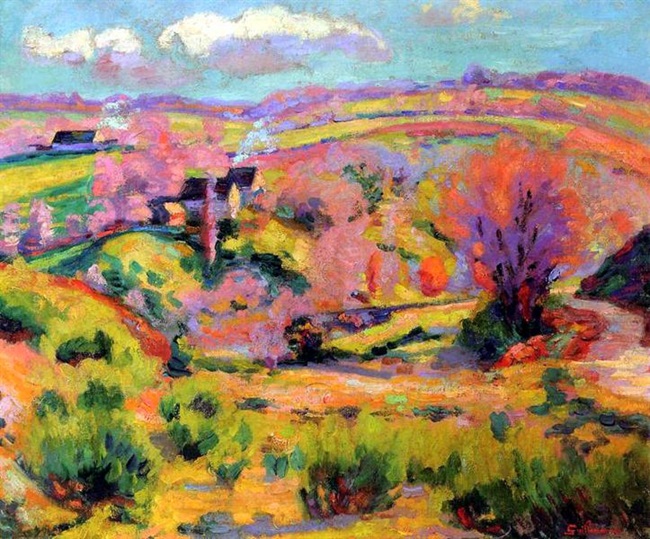
Armand Guillaumin, Landscape of Creuse in Spring
Eugène Alluaud, the reinventor
The Crozant School of Painters was a colony of artists constantly renewing itself. Amongst them was the artist Eugène Alluaud who is difficult to describe in a few words as he achieved so much in his life. He developed close friendships with Maurice Rollinat, Léon Detroy and Armand Guillaumin, whom he admired greatly for introducing him to the founding principles of Impressionism. He remains one of the most popular painters of the Crozant School, producing several hundred paintings between 1890 and 1940.
Born in Haute-Vienne to a family of porcelain makers and art lovers, he studied literature and science before studying art at the Julian Academy, after which he travelled widely across Europe and North Africa. It was on a visit to the Creuse in 1887 that he became enthralled with its wild landscapes. Encouraged by Detroy, he returned to Crozant in 1891, with his wife Marcelle. Here, life was very different.
The countryside around Crozant was secluded and remote, but in the village itself, the atmosphere was very different with many tourists coming to see the countryside of George Sand. Alluaud was an extremely sociable man and in true George Sand style, he entertained many artists and writers of his time at the villa he built in Crozant. He was equally as happy in the company of the farmers and workers of the countryside and participated wholeheartedly in local projects, helping a passing young artist to organize a puppet show, organizing a fishing competition and, making promotional posters for the Railway from Orléans. In 1947, just before his death he produced illustrations for a book dedicated to the Sédelle river. Finding himself frequently compared with Guillaumin, he constantly reinvented himself by learning from evolving artistic trends and became recognised for his signature use of the colour green.
By the 1920’s, inspired by Cézanne’s paintings, he moved towards Fauvism saying: “It is not a question of painting Nature, a vague entity, but a dawn, a fog, reflections, a granite or limestone river, a particular time of day with its characteristic tones. The line, finally, does not exist in nature; there are only colours.”
When Jules Dupré and his brother Victor first came to the Creuse in 1832, to paint ‘en plein air’, they could not have known that over a hundred years later, over 400 artists would have followed in their footsteps. George Sand’s home, a hive of activity for the arts was nearby. The year after her death, a steady stream of artists from Léon Detroy to Monet, came to the Creuse to capture in painting the invincible power of the isolated countryside. Amongst them was Francis Picabia, who come to witness ‘this absolute Eden of landscape’. The site of the Crozant School of Painters is still today an important place for all painters and continues to flourish in the works of artists such as Edouard Henry-Laurent, Pierre Noailhac, Gaston Thierry, Danièle Demachy-Dantin, Jean-Marie Laberthonnière and many others.
I never did live on Rue Claude Monet, but each time I walk in the landscapes he and others painted, I hope a trick of light, a shadow, will, for a moment, make me part of their magical realism.
From France Today Magazine
Lead photo credit : The ruins of Crozant castle © Shutterstock
Share to: Facebook Twitter LinkedIn Email
More in 150 years of impressionism, art, Creuse, French art, French painters, Impressionism
By Anne Price
Leave a reply
Your email address will not be published. Required fields are marked *




REPLY